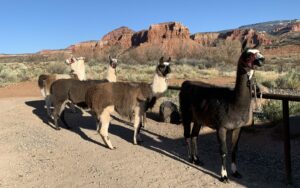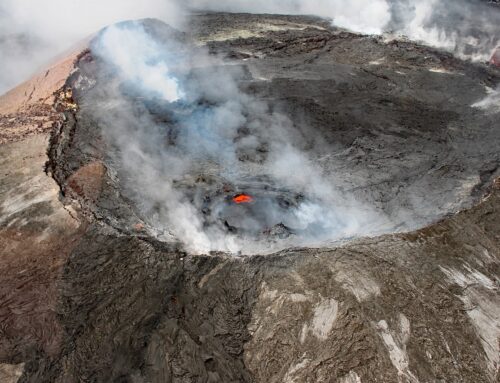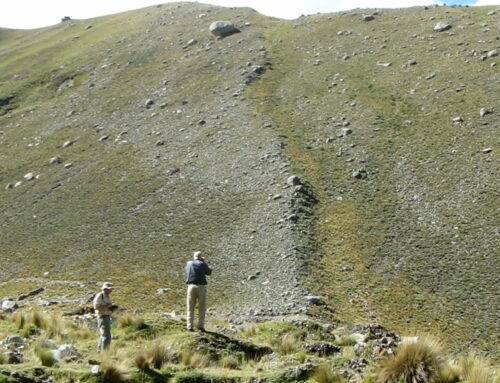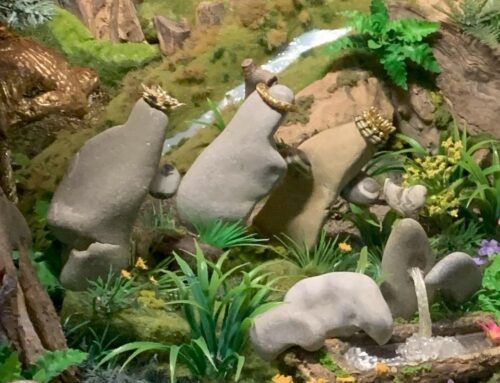Llamas, iconic animals of the Andes Mountains, have been the trusted companions of humans for thousands of years. Domesticated by the ancient Andeans, llamas have a prominent place in the geography and history of the Andes Mountains of South America (described in my book, The Monumental Andes, to be published in Fall 2024). Llamas have fascinated me since I was a teenager. In May 2020, I wrote a post: 10 Fascinating Things You May Not Know About Llamas. After describing these facts, I wrote:
While researching this post, I came across a company named Wilderness Ridge Trail Llamas. They conduct llama-supported day hikes and multi-night camping trips [adjacent to] Capitol Reef National Park in Utah. Since this park is one of my all-time favorites, the combination of hiking in Red Rock country with a llama is irresistible! This is definitely on my To Do Soon list!
In April 2024, almost four years later, I’m happy to report my good fortune in taking an overnight camping trip with Wilderness Ridge Trail Llamas. It was fabulous! Our group included two guides (one a trainee) and five handsome male llamas. As pack animals, males and females don’t work well together—the males bite and spit at each other while competing to win the attention of a female.

The llamas in our group had distinctive personalities, including how inclined they were to cooperate with their human handlers. Not surprisingly, the llama that our guides selected for me to lead was quite courteous and walked directly behind me with minimal corrections. Occasionally, his foot would bump against one of my boots—not in the forceful way that my grammar school classmates and I would sometimes “heel” each other – but with only gentle taps. I found this action endearing – I was happy to have a llama follow me while hiking; it was a new and novel experience.

Whenever our group stopped briefly, my llama and others in the group lost no time in grabbing a mouthful of grass, brush, or even Pinon pine needles. (I understand; I am an avid snacker as well.) Also, I learned that llamas occasionally hum. This can mean they are content, or annoyed, or probably just about anything else. At our campsite, I loved the soft background music of llamas humming.

A Long History of Camelids in the Americas
The camelid ancestors of llamas evolved on the Great Plains of North America around 40 million years ago (middle Eocene), where the lineage has a robust fossil record. About 2.7 million years ago, when the North American and South American continents first became joined by the Isthmus of Panama, camelids migrated to the South American continent as part of the Great American Interchange. Widespread extinctions of large mammals beginning around 12,000 to 10,000 years ago eliminated camels in North America, and only deer and the wooly coated guanaco and vicuña survived to become the largest native South American mammals. (I wrote more about these topics in a previous post, Chiles and Chocolate – Exchanges and Extinctions.)
The ancient Andeans domesticated llamas from wild guanacos about 4,000 to 5,000 years ago. Initially, people likely followed the herds of guanacos and gradually encouraged the animals to congregate in specific areas by improving pasture conditions. Later, by managing food supplies and then eventually separating and selectively breeding the animals, the Andeans produced the species—Llama glama—that differs from the wild ancestors. (Alpacas—Lama pacos—were domesticated from wild vicuñas; I describe the differences between these two camelids in my post Mug Shots: Llamas and Alpacas.)

Llamas are superb pack animals and excel at moving on rough, rocky, and steep terrain—just what people need in the Andes Mountains, and in wilderness areas of the Western United States. Llamas bred and trained for backcountry packing can carry 70 to 80 lbs. (32 to 36 kg) and they walk at about 2 mi/hour (1.6 km/hour)—a comfortable speed for their human handlers. When they are walking, they place each foot almost directly behind the foot that is just ahead, making them well adapted to narrow paths and ledges with steep drop-offs. They reportedly balance 65 to 70% of their weight on their front legs; their long and strong necks provide an effective counterbalance to a heavy pack.
 Instead of hooves, they have two-toed feet, with toenails and soft, moveable foot pads (similar to dogs). The two toes move independently for better gripping ability. Their camel heritage gives them an extremely long intestine in a complex plumbing system, allowing them to survive on much less water than other animals.
Instead of hooves, they have two-toed feet, with toenails and soft, moveable foot pads (similar to dogs). The two toes move independently for better gripping ability. Their camel heritage gives them an extremely long intestine in a complex plumbing system, allowing them to survive on much less water than other animals.
My llama adventure ended too soon. Whenever I was hiking during the following few days, I missed the companionship of a llama walking behind me.

SOURCES
My own photos, April 2024
Wilderness Ridge Trail Llamas is based in Idaho, https://wildernessridgetrailllamas.com/






Hi Roseanne,
I recently came back from South America where I spent some time with llamas. Unlike the yaks in Nepal, I found them pretty unruly and less ideal for trekking.
I find it fascinating that two very different cultures learned to use their local animals for similar purposes: Each uses their hair for clothing, their milk for cheese, they are used for carrying packs accross dangerous and rocky terrains, they help them stay warm with their body heat, and when they die, they are consumed. High in the Tibetan plateau, I once arrived at a village where a small hut had a sign that said ‘YakDonalds’.
In short, a very similar symbiosis that evolved in parallel and in very distant parts of our planet.
Thanks for your post.
Thanks, Leo! It is good to read your observations about yaks, as I am only vaguely familiar with those animals. And I assume the llamas you were with in South America were not as well trained as the ones on my trip. Llamas are very intelligent and curious animals, and definitely independent thinkers!
Another fascinating story
Thanks, Joey!